The 2023 post-harvest season is upon us and it's time to prep for your fall/winter weed control activities. The long-range forecast is calling for another wet winter, and November is the ideal time to plan your early winter weed control program, to check that your spray equipment is functioning properly and calibrated, and to clean your orchard floor of nuts and debris.
There are a variety of herbicides available today for our tree and vine production systems. No one herbicide will control all the weeds present, but choices exist to achieve excellent control for almost every weed combination. However, it takes patience and persistence to win the weed war. Before programs are decided, the following key questions should be discussed with your pest control adviser (PCA). Tree age, root stock, soil composition (sand, clay, gravel), irrigation design and practices, water source and quality, cultural practices used, a list of weed species present, and whether they are annual, biennial, or perennial weeds, your spray nozzle design, spray volume required, and if there are sensitive crops nearby. Discussing these questions early will provide the basis for your PCA to make the best recommendations possible while allowing your applicator to minimize the risk of crop injury or drift issues.
Advantages of early weed control
The advantage of implementing an early pre-emergent herbicide program, “before leaf fall occurs” is to get a jump start on winter germinating weeds at a time when they are just emerging and susceptible. Applying a pre-emergent ahead of a rain, or by activating with sprinklers, will control millions of weed seeds and provide a clean tree row for 4-6 months into spring. Applying a pre-emergent ahead of leaf drop also eliminates an additional operation of sweeping or blowing leaves after leaf drop has occurred. Weed control is enhanced and herbicide efficacy is extended when the herbicide is already in place before leaves cover the soil. A leaf barrier after an application inhibits weed germination and improves herbicide efficacy. As more orchards and vineyards turn to drip irrigation, relying on rain events to set herbicides becomes critical. A weed management program applying soil active herbicides early in the fall (November/December), and repeated in spring while rain events are still forth coming (March/May), will provide good weed control into summer. Orchards with sprinkler irrigation have more flexibility in timing their applications and selecting herbicides.
Pre-emergent herbicide use is also a recognized strategy to manage herbicide resistant weeds that have become established. We hear complaints every year that post-emergent herbicides are failing to control the same weeds they used to; and that higher application rates are needed to achieve the same level of control. Some of our more frequently used herbicides are developing weed resistance in the field: they include; glyphosate, paraquat, sethoxyodim, clethodim, rimsulfuron and other related acetolactate synthase (ALS) inhibiting herbicides.
Herbicide resistant weeds continue to spread across the state in different cropping systems, with the greatest occurrence in perennial orchards and vineyards. Problematic weeds include annual ryegrass, junglerice, goose grass, hairy fleabane, palmer's amaranth and horseweed or marestail with several other annual weeds close behind in developing resistance. There are several approaches to control these resistant weed species--but the best option by far is starting with a pre-emergent herbicide program early and attacking weed seeds at the point of germination.
New herbicides expected in 2023-2024
We are always anxious to share information from our various weed and herbicide research trials. But we never know for certain when a new herbicide will be registered for use in California. Two new herbicides are expected to be available this coming season, Florpyrauxifen-benzyl and a combination product with Indaziflam and Rimsulfuron.
Hulk (florpyrauxifen-benzyl) is a post emergent synthetic auxin mode of action HRAC (herbicide resistance action committee) group 4 herbicide from Corteva Agriscience. It is a foliar uptake and systemic herbicide that translocates through the phloem and xylem accumulating in meristematic tissue. It exhibits herbicidal symptoms of twisting and epinasty, typical of phenoxy herbicides. It targets many broadleaf weeds, typical of phenoxy herbicides, but with greater efficacy with certain weed species. Symptoms develop rapidly when plants are actively growing, but whole plant death may take several weeks to a month depending on the growth stage and environmental conditions. Currently, labeled crops include pome, stone, citrus and tree nuts. Grapes are being explored and may be added to the label in 2025. Tank mix partners are needed for emerged grasses which may include the use of glufosinate, glyphosate, clethodim and some ALS herbicides with post grass activity. Generally, one should avoid using contact herbicides that readily burn leaf tissue, like “paraquat” for example, since they may inhibit foliar absorption and systemic movement needed to control the weed. Check the label for specific recommendations.
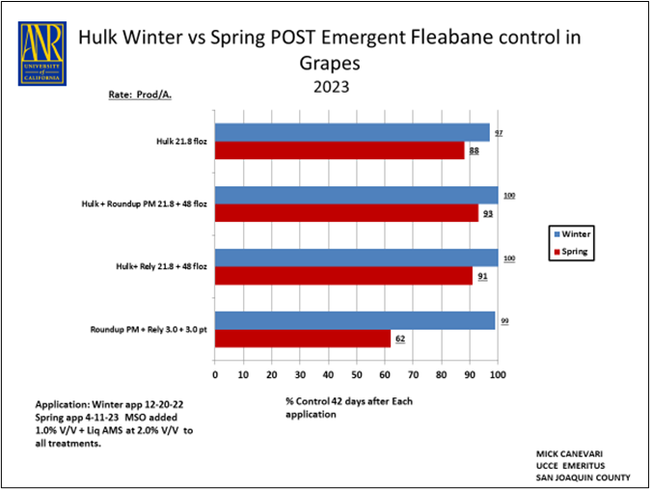
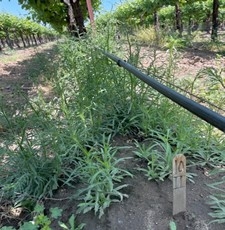
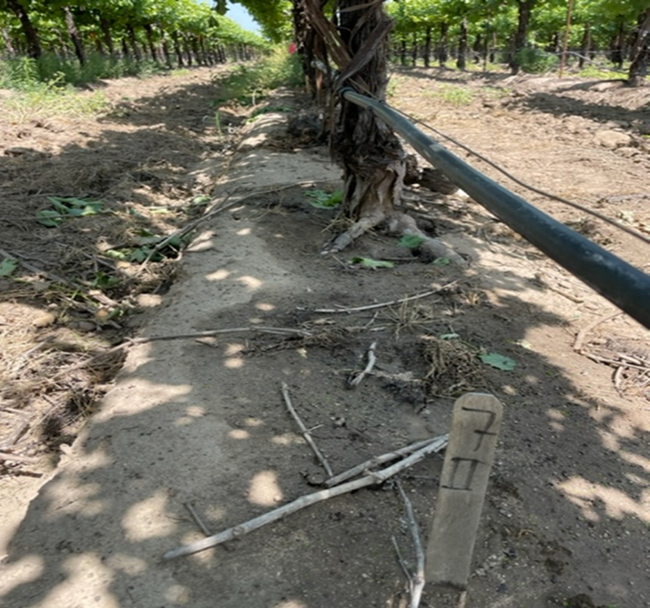
Centrus (Indaziflam + Rimsulfuron) is a pre-emergent herbicide from Helena Agri company packaged with two active ingredients and modes of action herbicides in HRAC group 29 & 2. Centrus will provide long term pre-emergence control over a broader spectrum of weeds and grasses. It is labeled for tree fruit, nut, and vines for residual weed control targeting winter and summer annual weeds common in orchard and vineyards, including annual ryegrass, filarees, fleabane-horseweed, malva, shepherd's purse, willowweed, knotweed, and many more. In all cases it will be necessary to add a post emergent herbicide for emerged weeds. By combining two active ingredients with different mode of actions, it broadens weed control across more species while slowing herbicide resistance to either active ingredient. We need to be mindful of mixing different modes of action herbicides and not using the same herbicides repeatedly. By mixing different mode of action herbicides we strive to keep our products viable for years to come.
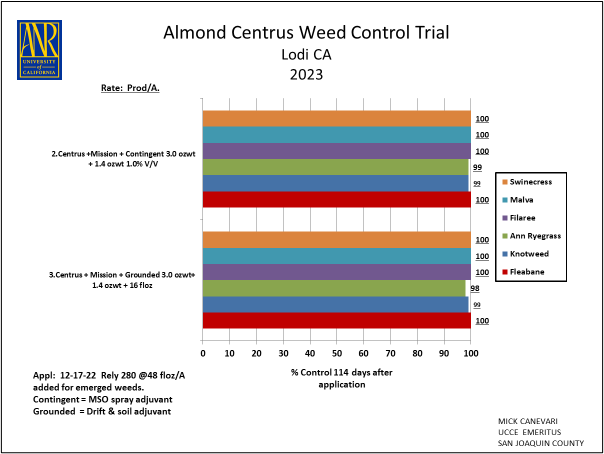
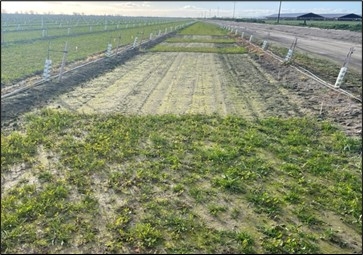
Overview of pre-emergent (before weed germination) herbicides currently registered
Craze (orthosulfamuron) HRAC Group 2 is a new 2022 broad-spectrum soil residual herbicide from Nichino America. The active ingredient in CRAZE is orthosulfamuron. This herbicide, an acetolactate synthase (ALS) inhibitor, works by inhibiting the enzyme responsible for the production of amino acids (valine, leucine, and isoleucine) essential for plant growth. CRAZE has demonstrated broad spectrum residual control of many broadleaf and grassy weeds including horseweed and fleabane and suppression of yellow nutsedge if applied in a timely pre-emergent manner. Several years of testing has demonstrated that it will fit into our Tree and Vine weed control program with flexibility and safety. In our testing, it included tank mix combinations with Alion, Chateau and Prowl which extended long-term control.
Prowl H2O and Surflan (pendimethalin & Oryzalin) are HRAC group 3 herbicides that have excellent annual grass control along with many broadleaves, especially those that germinate in the spring and summer. Surflan and Prowl are of the same mode of action and are similar in their weed spectrum and residual properties. Prowl H2O and Surflan remain stable on the soil without moisture no more than 21 days. Prowl is in the DNA family which controls weed seeds once the germination begins by inhibiting meristematic growth and plant cell division or mitosis, inhibiting seedling development. A common weed control strategy in the fall is to use a mode of action herbicide such as Chateau, Matrix, Alion, Pindar GT, Craze, and then switch to the DNA chemistry of Prowl/Surflan in the late winter or spring timing (February to May) to control summer annual broadleaf weeds and grasses. Prowl is an herbicide used for newly planted orchards because of its strong affinity of soil binding properties and safety to young trees. Prowl may be used before or after transplanting nonbearing nut and fruit crops and roots are covered with at least 2 inches of soil. Always follow the label instructions.
Chateau EZ (flumioxazin) is now in a new liquid formulation. Fortunately, the use rates and product rates for the new formulation remain the same, so the conversion from granular to liquid also remain the same. It is HRAC group 14, a long-lasting pre-emergent herbicide used for tree, nut, and vine crops. Applied between 8 -12 ounces per treated acre, Chateau enhances burndown of small broadleaf weeds and provides long residual control of difficult to control weeds such as fleabane and horseweed (marestail), malva, willow weed, filaree and a host of other winter weeds. Its broad-spectrum control of winter annuals makes it an excellent herbicide for use in the fall and early winter timing during the dormant period. Chateau at lower rates (6-8 ounces) has become a popular tank mix with other pre-emergent herbicides to extend control of more grass species and slow herbicide resistant issues. New Plantings: Chateau EZ provides early protection of new plantings from weeds. It can be applied immediately after planting according to label guidelines. Trunk protectors are required.
Matrix (rimsulfuron) HRAC group 2 is an ALS inhibitor pre-emergent herbicide active on many winter and summer weeds including fleabane, willow weed, and marestail, barnyard grass, jungle rice, crabgrass. Its broad-spectrum activity on grasses and broadleaf weeds, make it a good fit for an early fall application timing in November or December. It has become a popular herbicide to manage glyphosate resistant ryegrass pre-emergent and is effective post emergent on small emerged ryegrass. We have observed nice broad spectrum weed control when other pre-emergent herbicides are combined with Matrix. A post emergent herbicide should be added when weeds are emerged. Matrix is safe on young trees and a popular tank mix with Prowl or Trellis.
Mission (Flazasulfuron) is a HRAC group 2, an ALS inhibitor in the same family as rimsulfuron, orthosulfamuron (Matrix, Craze) with a similar weed spectrum. Our research has shown that Mission increased post emergent activity on certain weeds at a rate of 2.14 ounces per acre. Research from other Farm Advisors suggests improved yellow nutsedge activity when applied ahead of emergence with adequate water for soil incorporation. Use a post herbicide as a tank mix partner when weeds are up.
Alion (indaziflam) is a broad spectrum pre-emergent soil active herbicide registered in tree nuts and vines. It is a long-lasting soil residual herbicide exceptional in controlling many grasses and broadleaf weeds. It is effective on both winter and summer annual weeds, including fleabane, marestail, sowthistle, and willow weed, shepherd's purse, chickweed, and most grasses. At least 1/4 inch of water is needed to set and activate Alion as a soil residual. Since it is strictly a pre-emergent herbicide, it requires a tank mix with a post herbicide for emerged weeds, typically Rely, Matrix, Shark, Goal, Roundup, Venue, Treevix and Gramoxone are all compatible. Alion has shown to be an excellent tank mix partner with other pre-emergent herbicides to increase its weed spectrum, especially for malva and knotweed. Since it does not control weeds already germinated or just under the soil surface (called white phase) it should be tank mixed with herbicides that will control weeds just prior to emerging (Matrix, Mission, Pindar Gt or Goal are some popular choices).
Pindar GT (oxyfluorfen and penoxsulam) HRAC group 14 & 2 is a premix with two active ingredient herbicides. It combines both a pre- and post-emergence punch for many broadleaf weeds used in tree nuts and fruits but not registered in vineyards. An excellent herbicide for winter applications beginning in November to January, that can provide residual control lasting into spring and early summer. It is especially effective on fillaree, malva, henbit, willow weed, sowthistle, fleabane and marestail among others. If weeds have emerged, it is still recommended to combine it with a post emergent herbicide such as Roundup, Rely, or Gramoxone. If heavy grass pressure is anticipated in the orchard, an addition of Prowl, Matrix or Alion will extend long term grass control into spring. Within 14 days of application, a half-inch of water is needed to set and activate the herbicide.
Trellis (isoxaben) HRAC group 21 is registered for use in tree nut and fruit crops and for non- bearing newly planted orchards (check label for specific timing). It is a pre-emergent herbicide controlling only broadleaf weeds, therefore consider using another herbicide for grass control. Applied in the fall and winter timeframe, Trellis will provide 4-5 months of broadleaf control. It has no post-emergent activity; therefore, it must be tank mixed with the commonly used post emergent herbicides Trellis' mode of action is unique; it inhibits cellulose development making it a good rotational herbicide to manage weed resistance. If grass weeds are an issue, the addition of herbicides with grass control activity such as Prowl, Matrix, Alion, or Surflan are needed.
Broadworks (mesotrione) HRAC group 27 is registered in almond, walnut, pistachio and certain fruit crops. It is primarily a pre-emergent herbicide to control only broadleaf weeds hence the name Broadworks. We have observed some post activity on small broadleaf weeds (fleabane marsetail) when actively growing but to be safe will still require a post emergent herbicide partner for complete burn down control. Broadworks controls some of the more difficult broadleaf weeds in orchards but will need a pre-emergent tank mix partner that controls germinating grasses. We have observed a general reduction in bindweed populations when spring applications of Broadworks are used ahead of emergence.
Goal (oxyfluorfen)HRAC group 14 is a PPO (Protoporphyrinogen oxidase) post-emergent broadleaf herbicide with a soil residual of 1-3 months depending on the rate. Goal has been a mainstay in broadleaf weed control for decades and is especially useful in our fall orchard and vineyard programs as a burn down of broadleaves. It is regulated for application use due to its co-distillation (lift off in warm temperatures) issues subject to drift. Goal Tender is a different formulation of oxyfluorfen which reduces volatility issues associated with the 2XL formulation. Under our fall/winter conditions and weed species Goal is very good on malva, burning nettle, henbit, sowthistle, prickly lettuce and many more broadleaf annuals. It is weak on grass species and does miss some broadleafs as well. We encourage tank mixes with other pre-emergent herbicides of different HRAC groups for extending soil residual control.
Post-emergent herbicides (when weeds are up)
Embed Extra (2,4-D) HRAC group 4 post-emergent herbicide is registered on almonds, pistachios, walnuts, pecans and certain tree fruit. It controls a long list of broadleaf weeds, both winter and summer annuals, and broadleaf biennials and perennials including marestail, bindweed, fleabane and malva. Embed Extra is a new post-emergent phenoxy herbicide, containing choline formulation of the active ingredient 2,4-D which reduces the risk of volatility (soil lift off) while minimizing drift. The systemic action of Embed Extra provides a more thorough kill down to the roots of larger broadleaf weeds, that many contact herbicides struggle with. Embed Extra translocates at a slower pace in weeds than contact herbicides. A grower won't see immediate visible burn, since its mode of action is systemic, mimicking the action of the plant growth hormone affecting cell division and slowly twisting until dead. Embed Extra can be tank mixed with other post-emergent herbicides, such as glyphosate and glufosinate. It can also be tank mixed with many “residual”-type herbicides.” Our trials on spring treated larger plants of fleabane, marestail and willow weed showed excellent results.
Rely (glufosinate ammonium) a HRAC group 10 herbicide has become a mainstay for growers needing a broad spectrum burn down herbicide to control tough broadleaf weeds and grasses; willowweed, barnyardgrass, junglerice, crabgrass and glyphosate resistant fleabane and marestail. In recent years, the development and spread of glyphosate resistant weeds has shifted our growers to use more glufosinate herbicide in combination with other post emergent herbicides. Rely does not translocate totally like glyphosate, so the key to success is good coverage and smaller weed size. It is a popular tank mix with any of the pre-emergent herbicides. We have found that glufosinate plus other foliar herbicide combination to be very effective across most emerged weeds.
Treevix (saflufenacil) HRAC group 14 is a PPO (Protoporphyrinogen oxidase) post-emergent broadleaf herbicide with a short soil residual of approximately 30 days. It is registered in tree nut and fruit crops. It is recognized as an excellent post emergent herbicide for some of our toughest emerged broadleaf weeds. However, it is mostly effective on broadleaf weeds, and should be mixed with another herbicide to control emerged grasses. Like all post contact herbicides, treating small weeds, 1-6 inches tall and using a 20-40 gallon per acre (GPA) rate and thorough spray coverage is important. Treevix is excellent in controlling young fleabane, marestail, malva, willowweed, sowthistle, nettle, henbit, prickly lettuce, especially in cool conditions from fall through spring. It is not considered a long soil residual herbicide, so it should be mixed with a pre-emergent herbicide for soil residual control.
Shark, Venue (carfenthrazone, pyraflufen ethyl)are group 14 PPO herbicides. They are all post emergent herbicides especially effective on broadleaf weeds having little soil residual. Theyprovide a tank mix addition to pre-emergent herbicides to control emerged broadleaf weeds. They also work well with other post herbicides glyphosate and glufosinate (Roundup and Rely). A rule for these and all post-emergent herbicides, "Spray when weeds are small for better coverage and control!"
Roundup, Rely, Gramoxone, 2,4-D & PPO (group 14 herbicides) are registered for multiple use in nut and fruit orchards year around. Growers having certain weed species may need multiple post-emergent treatments for specific weed issues or escapes. Glyphosate is moderately effective on purple nutsedge with repeated applications prior to the six-leaf growth stage. Yellow nutsedge can be controlled by using 3-4 quarts per acre of glyphosate at two sequential application timings. Sandia has shown very good results to control emerged nutsedge but is not registered on almond. Sandia is registered for use in pistachio and walnut orchards. The key to nutsedge and other perennial weeds is persistence with repeated applications as it emerges and before it can regenerate new underground nutlets or rhizomes. Problem broadleaves such as fleabane, horseweed, malva, knotweed that germinate most of the year, should be targeted early at a small growth stage and controlled before seed heads develop. Vigilance and persistence are necessary until orchards mature and reach a full canopy of shade to slow perennials and other weeds from continuous germination.
NOTE: Before using any herbicide, always check the label for any use restrictions applicable to your area, crop, or soil type. Our comments and suggestions are from years of testing herbicides in our research plots and field trials. We appreciate our grower cooperators, who let us have access to their orchards. Again, always review and follow label instructions.
Originial source: November 2023 Field Notes newsletter